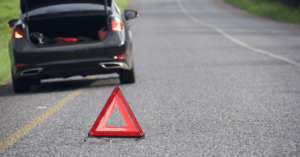Cross country road trips are probably one of the best ways to spend time with friends and family. There are so many places to visit in the United States, each with its own unique story and landscape. Depending on where you live, you might cover thousands of miles before you reach your destinations.
With road trips, it’s about the journey as much as it is about the destination! That being said, the last thing you want to deal with is car troubles. One way to avoid being stranded on the roadside of Montana with zero network coverage is to prepare your vehicle for the trip. Do your due diligence, and you’ll get where you’re going with no issues. We’ve put together a guide you can use as a makeshift checklist. Here are the essential things to check for before heading out on a road trip!

Know Your Car Before Embarking on a Cross Country Road Trip
Even though it should go without saying, you should know the overall state of your car. If you’re the type of person who takes automotive maintenance seriously and is always on time with oil changes, you should be good to go. Knowing your vehicle’s overall state is the precursor for anything we’re about to discuss in this guide.
Following the required maintenance schedule is the best way to minimize the chances of your car breaking down. That being said, mileage is definitely a factor. You can religiously change the oil every 6,000 miles and use the best parts, but if your car has 200,000 on the odometer, there’s always a chance for something to fail. Cars are full of components that wear out over time, and no amount of regular maintenance will help you determine when something might break.

Check All of the Fluids
Checking the fluids is one of the first steps when preparing for a long road trip. This means checking your engine’s oil level, brake fluid, power steering fluid if you have hydraulic power steering and transmission fluid.
A quick note – if your car is up for an oil change in a few hundred miles, do yourself a favor and do a preemptive oil change before you hit the road. It’s always better to flush the old oil out before a long road trip.
As far as transmission fluid goes, some cars have a dipstick that allows you to check it, but some don’t. In case you don’t have a way to measure the level of your transmission fluid and you haven’t changed it in a while, go ahead and get that done before you leave.
Brakes are arguably the most important system in any modern car. Being able to stop is much more important than being able to speed up, at least from a safety point of view. Make sure to check the brake fluid levels. In case you haven’t changed your brake fluid at least a year back, it’s highly recommended that you do that now.
Brake fluid should generally be changed every year or so. Additionally, if you notice that the brake fluid levels are slightly down, that could indicate increased pad wear. Last but not least, top off the windshield washer fluid.

Do a Thorough Inspection of the Braking System
With all fluids in check, it’s time to do a thorough brakes inspection. Since we’ve already checked the fluid, we’ll move on to inspecting all four corners of the car. Remove the wheels one by one as you go around the vehicle, taking a good look at the brakes. Take note of the brake pads, rotors, and the calipers.
Check the Pads
Make sure that your pads aren’t worn out or close to being worn out. Remember, you’re going on a cross country road trip, so even if there’s a little bit of meat on there, that might not last you the entire trip. If the pads are up for replacement, we recommend going with Brembo brake pads or pads from a similarly reputable brand.
Look for Warped Rotors
Next up are the brake rotors. Check for rotor deformation and wear. Rotor deformation can be caused by running a set of glowing hot brakes through a deep puddle. It doesn’t take much under the right circumstances. Warped rotors aren’t all that effective.
Lastly, check the brake lines for leaks or any indication of wear. Rubber gets brittle over time and will crack. While you’re at it, make sure that all of the ABS cables are clean, healthy, and working.
Inspect All of the Rubber Hoses
Older vehicles or cars with a higher number of miles on the clock can have issues with rubber hoses and other rubber components. Rubber has this awful habit of becoming brittle over time. Given enough exposure, rubber hoses will start cracking and breaking, which can be a problem. It’s not that bad if you get a cracked coolant line one block away from your home. It’s a whole different ball game when you’re in a different state in a small county where you have no contacts.
Hoses, Coolant Lines and More
Go around the engine bay and check every rubber hose and line you can get your hands. Start by checking the coolant lines as they are the most susceptible. Then move on to vacuum hoses, fuel lines, and others. You can also check the airbox assembly, especially the portion between the MAF sensor and the intake.
Rubber hoses and lines should feel somewhat soft and flexible. If you squeeze a hose and it is rock hard, chances are it’s time for a replacement.

Suspension
Next up is the suspension system. While going over all of the components might be overkill, there are a few things you can quickly check before the road trip. For starters, give your struts a good look. Check if they’re leaking or if the rubber boots on them are broken. Check the sway bar links, control arms, and tie rod ends.
All of these are easily inspected either by simply looking at them or by lifting the front of the car and wiggling the wheel. Wiggle the wheel back and forth by placing your hands on the 9 and 3 o’clock position, then do the same with 12 and 6 o’clock position. There should be no clunking noises or excessive movement. If you notice anything too excessive, make sure to get that taken care of before you leave.
This is also an excellent time to check the CV joint booth. CV joints rely on the rubber booth to keep them protected from debris. If the rubber booth is cracked or ripped, the CV joint will eat it sooner rather than later.

Belts, Tires and Miscellaneous Rubber Components
If all of the hoses are alright, check the drive belt and the accessory belt. You’re looking for visible signs of cracking, maybe even rot, depending on how much time has passed since you last changed any of these components. As long as you’ve followed the factory maintenance schedule, you should be fine. Still, give everything a look over just in case.
Next up are the tires. Check if the tires are inflated to the specified PSI. Check the tread depth and look for odd wear patterns. If you notice that the inside of the tires is worn out more than the outside, that could indicate alignment or suspension issues. Don’t forget to check the spare wheel as well. Those will do no good to you if they’re deflated.
Lastly, check your windshield wipers. Make sure that they’re not too old and brittle. Being able to see during a rainstorm is kind of important, and rock-solid wiper blades won’t help you one bit. If possible, get yourself a pair of silicone blades. They do wonders in heavy rain.

Lights and Signalization
Last but not least, there are lights and signalization. Checking the signalization system is often overlooked during a pre-road trip vehicle inspection. Being able to see and be seen on the road is imperative for safety.
Do a complete signalization system inspection by turning on all four blinkers, your low and high beams, fog lights if you have them, reverse lights, and brake lights. If you don’t have anyone to help you check the brake lights, simply back the car up next to a structure and watch for the brake lights to come on in your rearview mirror.

Gas Up and Enjoy the Ride
If everything checks out and you’re satisfied with the state of your vehicle, all you’re left to do is gas it up and head out. While a thorough inspection greatly reduces your chances of having to deal with a breakdown, it won’t guarantee a worry-free trip. You should always be prepared to deal with issues, just in case. It’s a good idea to carry at least the basic set of tools with you at all times.




